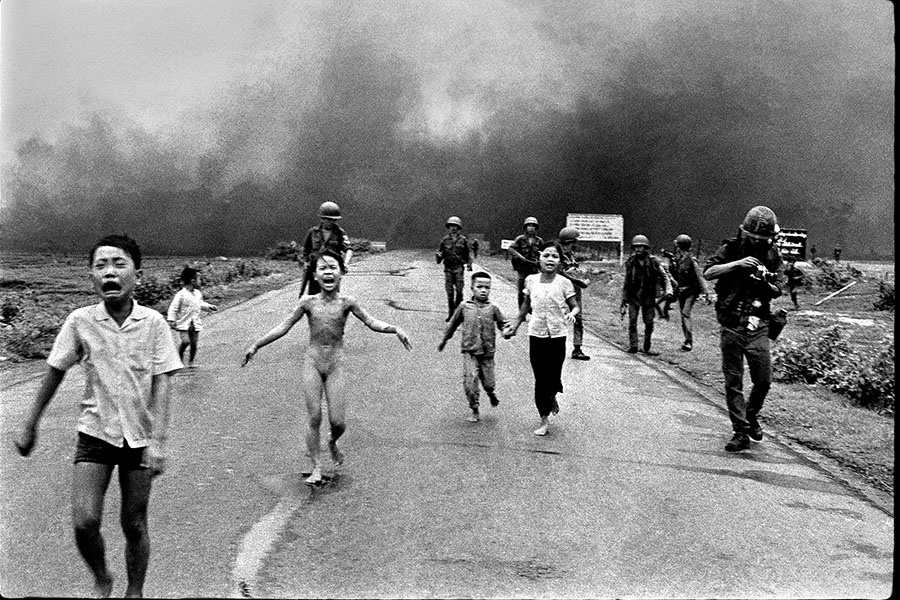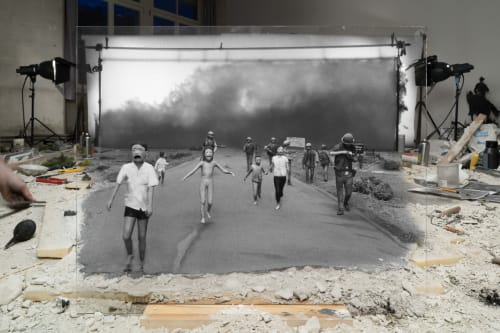Over the years, the Vietnam War has become inextricably linked with the poignant image of the naked, running girl, whose napalm sticks to her skin. “Too hot, too hot!” screams Kim Phuc. War photographer Huynh Cong "Nick" Ut of the Associated Press (AP) printed, and saved her life. That is 50 years ago today.

Napalm was developed in 1942. It is gasoline, to which a thickener has been added. It slows the combustion of gasoline and is mainly used in incendiary bombs. Napalm causes severe burns in humans and animals. IMAGE AP/NICK UT
June 8, 1972. 9-year-old Phan Thi Kim Phuc is playing with other children at the temple in the South Vietnamese village of Trảng Bàng, about 45 kilometers northwest of Saigon. Suddenly she hears the deafening noise of an airplane. Then explosions and smoke. Unbearable pain. Kim runs away, but she can't avoid the napalm. Today Kim Phuc has been known around the world as the "Napalm Girl" for fifty years. Because of that one iconic photo that photographer Nick Ut took of her in which you can almost feel the devastation and pain of the girl. Ut was awarded the Pulitzer Prize for his photo, which made headlines worldwide. The photo was titled The terror of war, but is better known as Napalm girl.
Simple Life
Kim Phuc was doing quite well in her village until that horrific day of the bombing carried out by South Vietnamese bombers. The intention was to eliminate the Viet Cong and North Vietnamese troops, but the own South Vietnamese civilians still left behind in Trảng Bàng were also hit. “My mother says I laughed a lot as a little girl,” she writes in The New York Times. “We had a simple life with plenty of food because my family owned a farm and my mother ran the best restaurant in the village.” Kim Phuc loved going to school and often played with her nieces and nephews and with the other children of the village. The four napalm bombs that fell on Trảng Bàng on June 8, 1972, made that life go up in smoke for good.
Lots of questions about the photo
The photo itself would also change Kim Phuc's life forever. She hated the picture growing up. "I'm a little girl there, naked. Why did he take that photo? Why didn't my parents protect me? Why did he print that photo? Why was I the only naked child when my brothers and nieces in the photo were still wearing their clothes? I felt ugly and ashamed.”
"But he also saved my life," Phuc continues in her letter to The New York Times about the photographer. “After he took the photo, he put down his camera, wrapped me in a blanket and took me away for medical attention. I am eternally grateful to him.”
The girl's clothes were burned off and she walked over to Ut. "Then she yelled at her brother that she thought she was dying and wanted water," the photographer wrote in The Washington Post. “I immediately put down my cameras so I could help her. I knew that was more important than taking more pictures. I took my canteen to make her drink and poured water over her body, but that caused even more pain. I didn't know that when people are so badly burned, you can't put water on them.' Still in shock, Ut drove all the children in his van from AP to the nearest hospital. “I'm dying, I'm dying,” the girl kept screaming. Ut thought she was going to die in the van.
mortuary
The doctors in the hospital also did not give her a chance to survive and did not even want to admit her. They put her in the morgue. "I showed them my press card and said, 'If one of them dies, I'll make sure the whole world knows.'" Then they brought Kim Phuc in. “I have never regretted that decision,” the photographer wrote. Kim spent about a year in the hospital. She survived, but two of her nephews did not, and her brother was seriously injured.
Kim Phuc is now 59 and she is in New York to celebrate the 50th anniversary of the iconic photo. Phuc suffered third-degree burns over a third of her body, causing intense and chronic pain. She was ashamed of her scars and deformities and tried to hide them under her clothes. “I had terrible anxiety and depression. Kids at school shrank from me. I was a figure to feel sorry for the neighbors and, to some extent, my parents too. I feared that no one would ever love me.”
The photo often prompted Phuc to conduct interviews and meet with dignitaries such as members of royal families and government leaders. The image of her and the other children became a symbol of the atrocities of the war. Kim Phuc didn't want that. "We are not symbols, we are people."
Foundation set up
It wasn't until she moved to Canada as an adult in 1992 that Phuc finally found peace. She co-founded a foundation to provide medical and psychological help to children who are victims of war and violence. Today, Phuc sees parallels to the Russian war in Ukraine, but also - "in a different way" - to the deadly shootings at American schools. "We may not see the corpses there like in foreign wars, but the attacks are the domestic equivalent of war."
“I am now grateful for the power of the photo of myself as a 9-year-old girl and for the journey I have traveled as a person,” Kim Phuc wrote in The New York Times. She says it took her a long time to do that. “Now, 50 years later, I can say that I'm glad Nick captured that moment, even with all the trouble that image caused me.” Phuc also maintains a belief in the good of people. “That photo will always serve as a reminder of the unspeakable evil that humanity is capable of. Yet I believe that peace, love, hope and forgiveness will always be more powerful than any weapon.”
Nick Ut (now 71) followed in the footsteps of his brother, Huynh Thanh My, who was also a photojournalist at AP. But Huynh died in 1965 while covering the Vietnam War. “I hope one day you can take a picture that ends the war,” his brother had told him, Nick Ut wrote in The Washington Post. “Today, many say my photo hastened the end of the Vietnam War.” That claim is based on the fact that after the photo was published in 1972, American public opinion became increasingly vehemently opposed to the Vietnam War.
Kim Phuc married Bui Huy Toan, a man from northern Vietnam, in Cuba. The couple honeymooned in Moscow in 1992 and crossed the border into Canada on their return flight, during a layover. They were not welcome there at first, but they were given political asylum when it became clear that she was the girl in the famous photo. The couple still lives in Toronto with their two children. Phuc works as an ambassador for Unesco.
"Even though she's always smiling, I can see her pain and what we saw and had to endure 50 years ago," Ut said. "To this day I consider her family. She calls me uncle and I often talk to her. But I will always hate the circumstances in which we met.”

